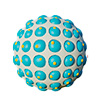| Feb 12, 2025 |
|
|
|
(Nanowerk Spotlight) The maxillofacial bone defects after the trauma, deformity, tumor, or infection may cause severe dysfunctions and dramatically decrease the life quality of patients. According to clinical data, there are about 2 million patients suffer from maxillofacial bone defects worldwide. The clinical treatments of maxillofacial bone defects pose significant challenges due to complex microenvironments, including severe inflammation, high levels of reactive oxygen species (ROS), and potential bacterial infection.
|
|
“Clearance of excessive ROS to provide an appropriate microenvironment for endogenous stem cells in mandible defects is an intriguing approach for promoting bone tissue regeneration in the treatment of inflammatory mandible defects,” explained Chong Cheng, professor and head of the Advanced Low-Dimensional Materials Group at Sichuan University. However, existing biocatalytic materials have limitations in ROS scavenging and tissue regeneration, making it difficult to meet the complex demands of bone repair microenvironments.
|
|
Recently, Professor Cheng’s team published a breakthrough study in Nature Communications (“Electron-donable heterojunctions with synergetic Ru-Cu pair sites for biocatalytic microenvironment modulations in inflammatory mandible defects”). They developed a highly efficient and precise electron-donable heterojunction with synergetic Ru-Cu pair sites (Ru-Cu/EDHJ) for superior biocatalytic regeneration of inflammatory mandible defects and pH-controlled antibacterial therapies.
|
 |
| Figure 1. Structure design and biocatalytic properties of Ru-Cu/EDHJ. (a) Structural and biocatalytic advantages of Ru-Cu/EDHJ when compared with Ru-O/EDHJ. (b) Graphical illustration for pH-controlled ROS biocatalysis of Ru-Cu/EDHJ. (c) The superior mandible defects repair and bioadaptive antibacterial properties of Ru-Cu/EDHJ. (Image courtesy of the researchers) (click on image to enlarge)
|
|
The research team previously found that Ru coordination with porphyrin networks on nanocarbon surfaces exhibits superior antioxidase-like activities, which can mimic the natural enzyme system to overcome the multielectron reactions of oxygen species via accelerating electron transfer for efficient redox balance. However, Ru-based artificial antioxidant enzymes designed from conventional metal oxides face challenges related to insufficient electron donors and coordination with highly electronegative oxygen atoms.
|
|
“Electronic metal-support interactions (EMSI) provide us with new design ideas,” explains Ting Wang, a doctoral student in Cheng’s team. “The unique heterojunction that we created can offer robust EMSI in catalytic systems, optimising the electronic structures of catalytic centers by providing necessary electrons and facilitating rapid electron transfer.”
|
|
They verified that the Ru-Cu coordination structure significantly enhances the electron density of Ru atoms compared to the Ru-O coordination structure, resulting in excellent antioxidase-like activities and pH-controlled ROS catalytic properties in Ru-Cu/EDHJ.
|
|
Cellular experiments have shown that the antioxidase-like Ru-Cu/EDHJ can maintain stem cell survival, proliferation, and osteogenic differentiation in high ROS-level conditions by preventing oxidative stress-induced DNA damage and cell apoptosis, maintaining the metabolism and osteogenesis functions, and reducing inflammatory responses. Moreover, the Ru-Cu/EDHJ also displays excellent pH-controlled antibacterial properties via peroxidase (POD)-like catalytic ROS production in acidic environments, which allows the Ru-Cu/EDHJ owns bioadaptive anti-infection activity in treating bacteria-induced refractory mandibular diseases.
|
|
After a series of treatments and examinations, the results of the research are exciting. While there is still more work to be done before human trials can begin, the team remains optimistic.
|
|
“The synthesized Ru-Cu/EDHJ exhibits superior and unexpected biocatalytic performances, which offers a promising pathway to create ROS biocatalytic materials for treating trauma, tumor, or infection-caused maxillofacial bone defects,” concluded Cheng.
|
|
Provided by Sichuan University
|
|
|


